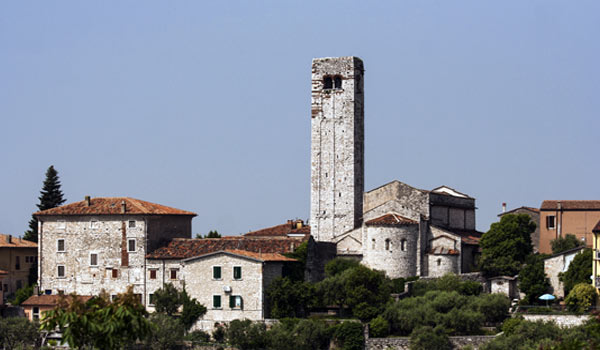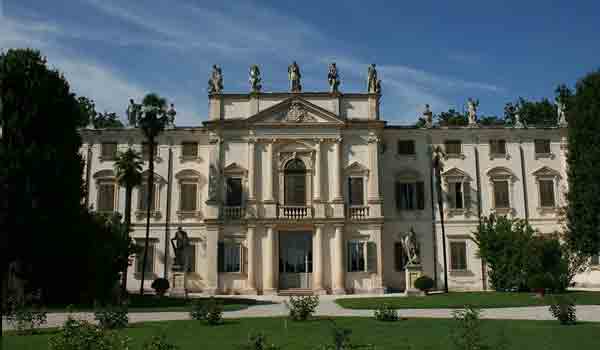San Floriano
Valpolicella Sights Guide
In the heart of Valpolicella, land of great wines, rises San Floriano, with its characteristic Romanesque façade, one of the most beautiful and elegant churches of Verona.

Info & Guided Tours:
+39 333 2199 645 info@veronissima.com P.I. 03616420232 C.F. CPPMHL74L13L781C
It was built on the place where in Roman times there was a cemetery, as demonstrated by the reuse of funerary stones in its walls.
It 's also been called a San Zeno in miniature and indeed, the tufa facade with its well-marked pilasters, the rampant arches and the rose window is very reminiscent of the most important church in Verona.
However, what makes San Floriano unique are the two lateral arches that, joining to the facade, create a particular harmony and refinement in the balance of forms making it unique and unmistakable.
The massive and squared bell tower completes the whole, making it a little jewel of Verona's Romanesque style.

The remains of the Roman temple dedicated to Flora not far from the pieve.
San Floriano is located in the center of Valpolicella, in the territory of San Pietro in Cariano, one of the villages which make up the Valpolicella Classica, the historical area of origin of the homonymous wines, in the hamlet of San Floriano. The church is located along the road which crosses the piedmont line of Valpolicella, from east to west, just at the height of the entrance for the Valgatara, one of the most beautiful valleys of the whole area.
The parish church is dedicated to Florian of Lorch, a Roman soldier who was stationed in Loriacum, today Lorch, in Austria and, like many of the early Christian martyrs, was executed once it was discovered that he belonged to the new religion that was spreading throughout the Roman Empire. Saint Florian is a saint traditionally venerated in Bavaria and Austria, and it is no coincidence, therefore, to see a parish church dedicated to him in the Verona area, which has always been a place of exchange between the two sides of the Alps, at the mouth of the Adige Valley, a natural route of communication with the Germanic world.
In reality, according to some scholars of the area, the church was erected near a pagan temple dedicated to the goddess Flora. Not infrequently, with the spread of Christianity, churches were appropriating the physical space occupied by places of worship of other religions. In this case, the church may have also appropriated the name, changing it from Flora to Florian. The remains of a circular temple dedicated to Flora, Roman goddess of nature and the harvest can still be seen in the elegant garden of a nearby winery. Valpolicella was the site of numerous pre-Roman settlements, with the Arusnati, and Roman settlements, with villas and temples, many of which were undoubtedly dedicated to the divinities of fertility, given the ancient vocation for winemaking.
In the walls of San Floriano there are numerous lapids and fragments of buildings from the Roman era. Many scholars believe that where the church stands today, in Roman times there was probably a necropolis.
The presence of the church is documented since the year 905 but the building of worship must surely be older. Certainly the church of San Floriano was damaged by the earthquake of 1117, the same that destroyed the outer wall of the Arena. The subsequent reconstruction took place in the middle of the Romanesque period and today San Floriano is one of the most beautiful examples of this architectural style. The facade in particular is strikingly reminiscent of San Zeno in Verona. San Floriano can almost be considered as a copy in miniature of San Zeno, both in the choice of material, the tuff with its warm color, both in form, with its simple and clean gabled structure, the lesene, the arches, the rosone and the prothyrum which, unlike its " big sister", is rampant. One of the most original features of the church are in the two arches that join the sides of the facade making it elegant and unmistakable.
The exterior of the pieve is completed by the massive belfry made of composite material and by the beautiful seventeenth-century cloister.
The interior of the church, with a nave and two aisles, was remodeled several times until the mid-1700s, and no longer retains much of the original layout, creating a great contrast with the facade.
San Floriano is ideally located for a stop along a tourist itinerary in Valpolicella tourist guides. Perfect for a guided tour that combines history, art, architecture and the area's excellent wines, above all Amarone.
If you have any questions or would like more detailed information about guided tours and tour itineraries with Valpolicella and Verona tour guides, please contact us
Info & Bookings:
+39 333 2199 645 info@veronissima.com P.I. 03616420232 C.F. CPPMHL74L13L781C

 IT
IT 日本
日本 DE
DE FR
FR 中文
中文 ES
ES




